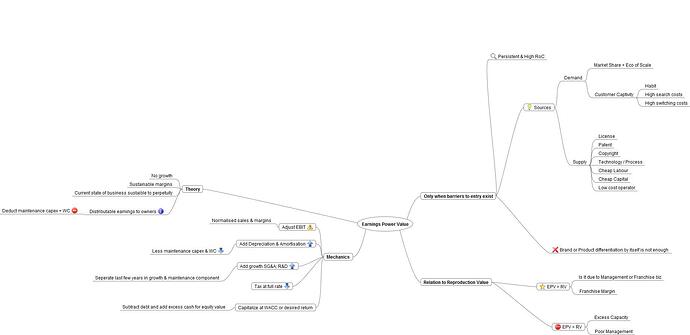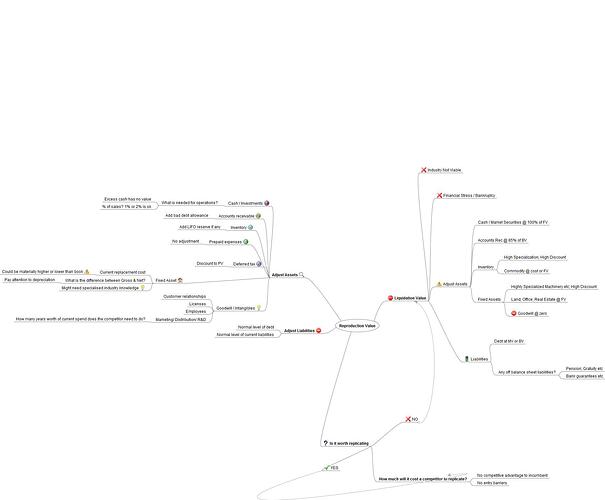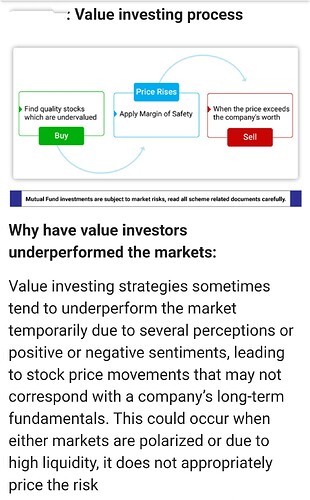Value Investing – Some Suggestions
10 MINUTES READING TIME
I’m feeling a sense of anxiety as I sit down to write this post, the final part of this series on value investing. I’m dreading the fact that what I write may upset a lot of value investors out there. My hope is that most will see this post for what it is: a constructive criticism of value investing as applied to current market conditions.
Value investing needs to become more flexible. I’m not suggesting that it should stray from its guiding principles. But the application and implementation of those principles needs to evolve to reflect the evolution of world, the economy and financial markets.
The answer to most investment questions is “it all depends”.
That’s the Market Fox ethos (see here and here): The future is uncertain and unknowable because it has yet to happen and so the answer to most questions is “it depends”. Accepting this principle means that emphasis shifts to creating a logical and evidence-based framework for thinking about the variables that the answers to our questions may depend on and how they change dynamically through time.
Value investing doesn’t happen in a vacuum and it’s time value investors need to pay attention to what’s happening around them.
Why Value Investors Shouldn’t Ignore Market Conditions
The value purists out there are reading this and probably thinking why should current conditions matter? There is a mountain of historical evidence and academic research proving that value works over the long-term. They’re thinking: “we’ll stick to our philosophy and process because the four most dangerous words in vesting are “this time is different””. Or my personal favourite: “this Market Fox post on why value investing is dead (that’s absolutely NOT what I’m saying) is probably a sign that value vs growth cycle is about to turn”.
Probably no answer that I can give will satisfy the purists. Which is why I’ll let the godfather of value investing – Benjamin Graham – illustrate why reflecting on current conditions matters. Here are his comments in what is probably the most famous piece of writing in the value investor’s cannon, Chapter 20 of the Intelligent Investor: Margin of Safety:
As we see it, the whole problem of common-stock investment under 1972 conditions lies in the fact that “in a typical case” the earning power is now much less than 9% on the price paid. Let us assume that by concentrating somewhat on the low-multiplier issues among large companies a defensive investor may now acquire equities at 12 times recent earnings – i.e., with an earnings return of 8.33% on cost. He may obtain a dividend yield of about 4% and he will have 4.33% of his cost reinvested in the business for his account. On this basis, the excess, the excess of stock earning power over bond interest over a ten-year basis would still be too small to constitute an adequate margin of safety. For that reason we feel that there are real risks now even in a diversified list of sound common stocks. The risks may be fully offset by the profit possibilities of the list; and indeed the investor may have no choice but to incur them – for otherwise, he may run an even greater risk of holding only fixed claims payable in steadily depreciating dollars. Nonetheless the investor would do well to recognise, and to accept as philosophically as he can, that the old package of good profit possibilities combined with small ultimate risk is no longer available to him.
Obviously, conditions today are quite different to those in the early 1970’s when inflation was rising and interest rates where a lot higher. That’s not the point. The point is that margin of safety, the bedrock on which value investing rests, is dynamic. Notice what Graham is doing in this passage. He is:
Assessing the prospects for value stocks in absolute terms
Comparing the earnings yield available in the market to the yield on treasury bonds
Acknowledging that the margin of safety is not static
Notice also what’s not said. There are no “value always works in the long-run” platitudes.
Don’t just quote Ben Graham when it suits on your website or in your pitchbooks! Go out there and test whether your assumptions still hold. Develop a framework for assessing how your opportunity set changes dynamically over time.
Market Conditions – Where are we now?
Earlier posts in this series have considered market conditions in detail (you can find them here). In summary, value stocks are now expensive in absolute terms and this increases the risk of the following problems affecting value investors.
A higher overall valuation level probably increases the proportion of losing value stocks as they now have further to fall.
The winners may not be as big since they’re starting form a valuation level that’s significantly higher.
This means that the negative performance impact of losers on overall portfolio returns is probably going to be worse.
The margin of safety is smaller. Consequently, future returns are also lower.
Time pressure increases. Investors need the margin of safety to close much faster if they hope to beat the market.
The need to trade more frequently (to get out of losers or realize winners) increases. Consequently, trading costs and taxes becomes more of an issue.
It’s harder to find new opportunities – increasing reinvestment risk.
Growth becomes more problematic as you’re paying more for low quality companies.
Hopefully, I’ve convinced you that I’m not just another value investor that’s capitulated and gone to the “dark side” of growth investing.
maxresdefault
What should value investors do? Here are 5 suggestions.
Consider long-short strategies
Depart from your screens
Construct portfolios differently
Risk management can be a margin of safety too
Ignore what other people think
Consider long-short strategies
Benjamin Graham acknowledged that the overall valuation-level of the stock market, inflation and interest rates has a powerful effect on the absolute performance of value investing and that value investors should consider these variables when setting their expectations.
The value investors that I talk to frequently point out that just because the absolute case for value is less attractive, it doesn’t necessarily follow that the relative case for value is also less attractive.
OK, fair point. What should investors do if the overall market is expensive but the spread between value and growth stocks is wide? One option would be to consider investing in value as a market-neutral factor, that is long cheap stocks/short expensive stocks.
Long/short implementation allows investors to capture the spread between cheap and expensive stocks while insulating them from the stock-market’s high valuation level.
It also offers some protection against the current high absolute valuation level of cheap stocks. Even if these stocks underperform, the spread between value and growth can still be positive, so long as growth stocks do worse.
Depart from your screens
A lot of fundamental value investors begin with some sort of screening process. They employ a team of analysts to carefully select what they think are the best stocks identified by the screen.
Fund managers investing this way are highly unlikely to out-perform a simple, low-cost, rules-based value strategy.
Here’s why. Value investing involves buying a company at a discount to its assets or its normalised earnings or cash flow. Often little attention is paid to future growth. Consequently, of the information required already exists. It is either historical (balance sheet, profit and loss, cash flows) or current (price).
That’s why the fundamental manager’s use screens in the first place. They wouldn’t do it if it didn’t work!
Can a manager beat their screen? Yes, but it’s very tough to do. The screen promotes consistency. Consistency is crucial when you’re sampling from a distribution where you have:
A larger number of losers than winners
2-3 years to get it right or get out
A need to reinvest frequently
Where missing winners really hurts
Where losers can dominate results
Why does consistency matter? It results in fewer mistakes. And as we’ve already considered, in value investing mistakes often have the largest impact on performance.
So, what should fundamental value investors do? They should focus on the neglected corners of the market where their skills and experience can add value. They should be focusing on distressed and special situations, micro caps stocks, etc.
Leave large and mid-cap, benchmark relative value investing to the quants. They can do it cheaper and in many cases the net performance is comparable.
Of course, this will mean that many fundamental value investors will have shrink their business. It will also mean that the need to construct portfolios very differently.
Construct portfolios differently
Benchmark-relative value portfolios make little sense if the benchmark is expensive. Why would a value investor ever choose a benchmark as a starting point if it has a reduced margin of safety?
To maximise capacity, improve liquidity and minimise tracking error that’s why. It’s a business choice to maximise assets under management and fees while at the same time minimising the risk of being fired for under-performing the market.
I wish more value investors would pay less attention to benchmarks. It’s a sad irony that they don’t because a benchmark focus undercuts their product offering.
Standard value investor pitch:*
We are old-school, Graham and Dodd or Buffett-style value investors
We don’t try to time the market and we don’t pay attention to the economy
Value investing has always worked over the long-term and we expect this will continue
We stick to our process and philosophy no matter what
Value investing works because it’s painful for most people to be contrarian
It’s less risky because we always insist on a margin of safety
We buy businesses and not stocks
There are always bargains if you are disciplined and patient
*Portfolios may contain upwards of 75 stocks. All portfolios are subject to sector and country constraints. Ex-ante tracking error is kept below x%. The fund remains fully invested at all times.
I don’t put all the blame on fund managers. After all, they are often giving their clients what they want. Many clients like the “idea” of value, but they are less enthusiastic about the “reality”. What they may not appreciate is that a half-hearted value strategy is highly likely to end up with the worst of both worlds – all the risk of a value strategy with a lot less reward.
Investors can control their risk of short-term underperformance by simply allocating less to a “real” value strategy and allocating the balance to an index fund. This way a fund manager isn’t forced construct a portfolio that strips out most of the excess return and leaves most of the relative performance risk.
Risk management can be a margin of safety too
Most value investors rely buying a stock for less than their estimate of intrinsic value, or a margin of safety, to reduce risk. But as we’ve considered in previous posts, the current margin of safety across most value stocks is quite narrow. This increases the risk of a traditional value strategy.
Are there any other ways that value investors can control risk? Yes, by cutting losses and letting winners run. As heretical as this might sound, I believe that value investors should borrow some of the risk management tools used by traders.
The very first post in this series highlighted the positively-skewed distribution of value stock returns. That is, the value premium is driven by a few really big winners that overcome the drag created by lots of losers.
If the distribution of value stocks is positively-skewed, doesn’t it make sense to use a sell discipline that’s also positively-skewed? Instead, most value investors do the exact opposite. They employ a negatively-skewed strategy. That is, they sell stocks that have increased in price (i.e. reached their “target price”) only to buy more of stocks that have continued to fall in value.
In other words, they are statistically more likely to sell the big winners (that they need to capture the value premium) too early and more likely to increase their holdings in stocks that continue falling in price.
The classic objections to this sort of thinking is that value investors need to be “disciplined” and that there are always new cheap stocks to invest in. But does that still hold in a market where the cheapest stocks are significantly more expensive?
Ignore what other (uninformed) people think
A few weeks ago, I sat down with a portfolio manager running a global value strategy to discuss the topic of letting winners run. Here’s how our conversation went:
Portfolio Manager: We’ve identified this pattern in our portfolio. We routinely sell our winners too early. We’ve done well, but it’s definitely cost us.
Me: Good to hear that you’ve analysing your portfolio to see what does/doesn’t work. Why don’t you consider revising your sell discipline?
Portfolio Manager: We’ve thought about it. But if we held onto these stocks the weighted-average P/E of the portfolio would go up. We’d then get a call from the fund ratings consultants asking “why is the P/E of your portfolio so high? Aren’t you supposed to be a value manager?” It may affect our rating.
Me: Let me check if I understand you correctly. You believe that there’s still value in these stocks and you know from an examination of past results that the odds suggest that you’re better off holding them. But you’re worried that this will affect your fund rating?
Portfolio Manager: Yes.
Me: That makes absolutely no sense. How do you ever hope to succeed by letting your investment strategy be dictated by someone else?
A similar story applies to turnover. Value fund managers know that most clients and consultants favour lower-turnover strategies. But value has to converge with price within 2-3 years for the value investor to make money (see my earlier post). That implies a turnover of 33-50%. Turnover goes even higher if fund managers start selling losers. Once again, fund managers risk allowing consultants and clients to drive the strategy.






